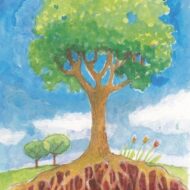Everybody has a passion. For each individual there is at least some activity that once involved in it, time seems to stop. You enter into the flow and an unspeakable sense of order fills your being — as Thomas Arthur says about juggling, “It feels like coming home.” This past month I shape shifted into a roadie, creative consultant, videographer, and spokeswoman for the child’s perspective, touring through British Columbia with Thomas as he performed for elementary and high school students across the province. Encouragement to listen to and follow your patterns, discovering your passions, was among the many treasures glowing in his performance, Patterns Shaping Time: Poetry in Motion.
Thomas entertains and interacts with his audience as a juggler, storyteller, dancer, comedian, science teacher, math teacher, music teacher, illusion aficionado that generously reveals his secrets, and an inspirational role model. One principal noted, “Of all the talented performers that we’ve had come through this school, I’ve never seen anyone touch every single student as you just did.” As an observer amongst the audience, I can attest to the truth in this statement. At the height of the tour, Thomas was reaching out to 1000 children a day for 5 days straight and on some level, each child was affected by his presence. Whether it was through his captivating and awe inspiring juggling and movement, the mystique of the illusions he shared, the opportunity to be on stage and experience rhythm, balance, and juggling, the chance to ask questions and express curiosity, or both the silent and expressed invitations to physically and vocally participate in the show, it appeared that every child was in some moment personally invested and involved in the show. Watching the performance becomes a visceral experience of feeling the sounds, rhythms, and patterns move through space and through one’s own body. Excitement and desire to join and participate (both in one’s seat and on stage) uncontrollably bubbles up in moments of awe, amazement, and inspiration.
Most impressive to me was the various modes of expression that Thomas uses to communicate. The instrument of his human body is optimized to the fullest capacity, illustrating the fluidity of motion and the order of rhythm through his movements, accentuating emotional charges with brightly animated facial expressions, and giving voice and shape to motion and movement through lyrical sounds. On many occasions, Thomas was accompanied by a sign language interpreter. It was fascinating to watch as they seemed to sign not only his words, but his motions and the emotional connotations embedded in his actions. Throughout the performance, Thomas is accompanied with objects such as wooden spiral roots and a metal garden spiral that come to life when spun by his presence. During these parts of the show, the interpreters would sign the motions and movements of the objects. In the habit of expressing that which is being communicated, it appeared that the signers felt compelled to translate a means of expression that was quite perceivable to a hearing impaired child. This was a beautiful example of the prominence of nonverbal forms of communication in Thomas’ show. By communicating in so many different ways, Thomas symbolically spoke many different languages, following threads that touch the audience’s mind, body, heart, and soul.
It was an honor to be a part of and witness to this beautiful show, watching as it rippled through the audience seeping out into the world!
